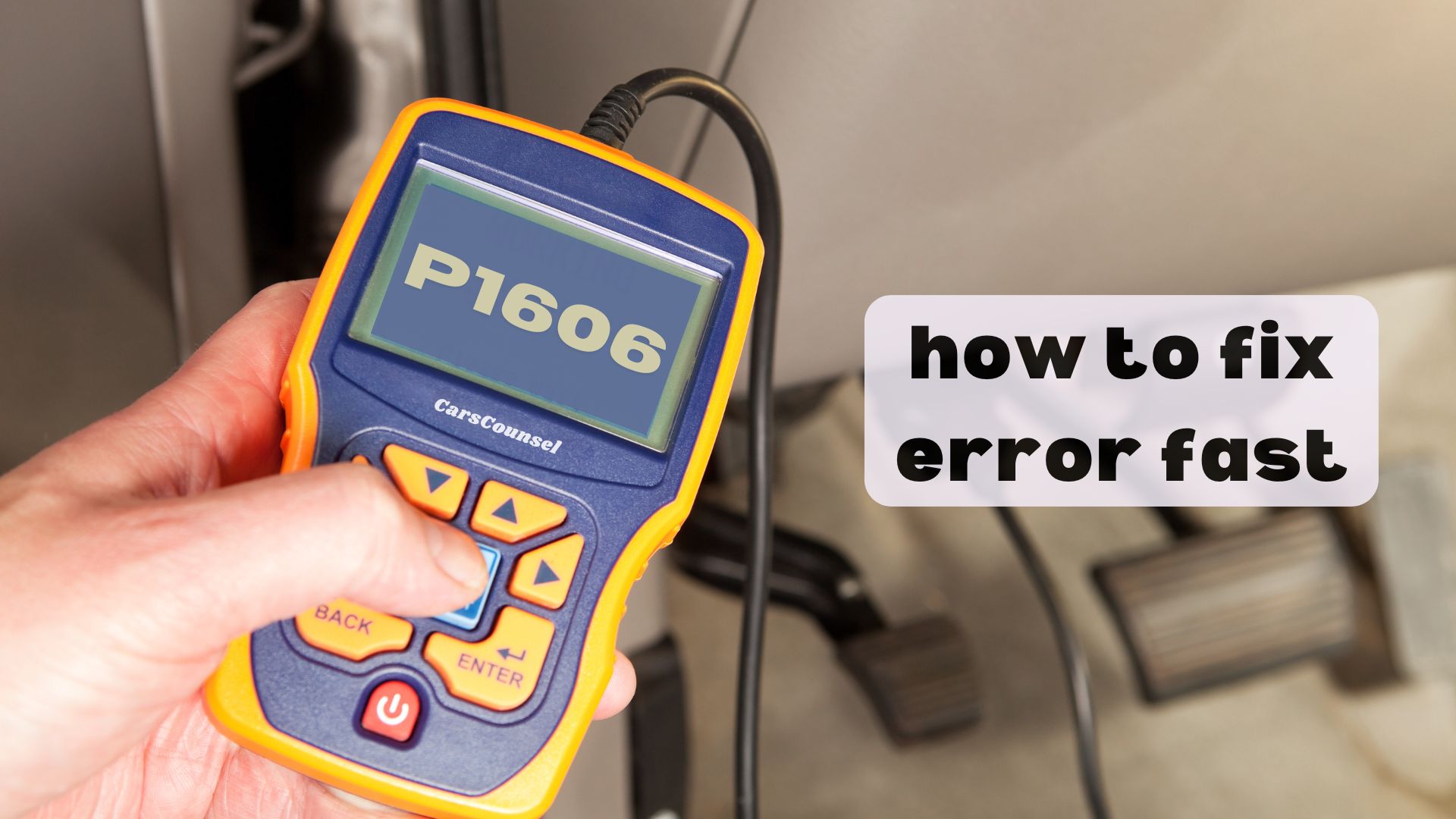You might not know that your vehicle’s Variable Valve Event and Lift (VVEL) control module is constantly working behind the scenes to optimize engine performance and reduce emissions.
But when this module malfunctions, it can trigger the P1606 code, leading to issues like a check engine light, engine stalling, and reduced performance.
What you’re probably wondering is, what’s causing this problem and how can you fix it? Is it a faulty component, wiring issue, or software glitch? To get your vehicle running smoothly again, you’ll need to uncover the root cause of the issue – and that’s exactly where we’re about to take a closer look.

Quick Navigation
Key Takeaways
- The P1606 code indicates a problem with the VVEL control module, which can cause the check engine light to illuminate on the dashboard.
- Faulty VVEL control module or solenoid, wiring or connector issues, and low battery voltage are common causes of the P1606 code.
- Symptoms of the P1606 code include engine stalling or misfiring, reduced engine performance, and decreased fuel efficiency.
- Diagnosis and repair may involve using a scan tool, visual inspection, and replacement of faulty components or repair of wiring issues.
- Regular maintenance, such as checking and maintaining proper battery voltage, can help prevent the P1606 code from occurring.
P1606 Code Description
Your vehicle’s engine management system relies on the Variable Valve Event and Lift (VVEL) control module to optimize engine performance and efficiency.
This advanced technology controls the timing and duration of the opening and closing of the intake valves, allowing your engine to run smoothly and efficiently. When the VVEL control module functions correctly, it guarantees improved engine performance, better fuel efficiency, and reduced emissions.
However, if the module malfunctions, it can lead to issues with engine performance, fuel efficiency, and emissions, ultimately affecting your vehicle’s reliability.
The P1606 code is triggered when the VVEL control module detects a fault, certifying the Check Engine Light on your dashboard.
Common Causes of Fault
When the P1606 code is triggered, it’s essential to identify the root cause of the issue to guarantee a proper repair.
You’ll need to investigate the possible causes, which may include a faulty VVEL control module, wiring or connector issues, software glitches, or engine mechanical problems affecting the VVEL system.
Faulty sensors, such as those related to the accelerator, can also contribute to the problem.
Electrical issues within the VVEL system can’t be ruled out either.
By pinpointing the exact cause, you’ll be able to develop an effective repair strategy.
Remember to inspect the wiring and connectors, check for software updates, and test the VVEL control module and related components for proper functionality.
VVEL System Symptoms
One of the most critical aspects of diagnosing a P1606 code is recognizing the symptoms of a faulty VVEL system.
You may notice a loss of power or acceleration, rough idling, or stalling when driving. Decreased fuel efficiency is another common symptom, which can be frustrating and costly.
The Check Engine Light may also illuminate on your dashboard. In addition, engine misfires can occur, affecting your vehicle’s overall engine performance.
As you experience these issues, it’s essential to address the problem promptly to prevent further damage and costly repairs. By being aware of these symptoms, you can take the first step in identifying and fixing the underlying cause of the P1606 code.
Diagnostic and Repair Steps
To diagnose and repair a P1606 code, you’ll need to follow a structured approach to identify the root cause of the issue.
Start by establishing scan tool connectivity to access the vehicle’s onboard diagnostics. Then, prioritize the fault codes to guarantee you’re addressing the most critical issue first.
Review the code description and symptoms to understand the possible causes of the P1606 code. Next, use the scan tool to retrieve any stored trouble codes and freeze frame data to help pinpoint the problem.
Fault code prioritization will help you confirm you focus on the most likely cause of the issue, saving you time and effort in the repair process.
Wiring and Connector Issues
Inspecting the wiring and connectors related to the VVEL control module is a crucial step in diagnosing P1606 code issues, as faults in these components can disrupt the entire system.
You’ll want to perform a thorough wire inspection, checking for signs of damage, wear, or corrosion. Corrosion testing can help identify any issues that may not be immediately visible.
Make sure to inspect the connectors and terminals as well, verifying they’re clean and free of corrosion. Any damaged or corroded components should be replaced to guarantee proper communication between the VVEL control module and the engine management system.
Software Glitches and Updates
After addressing wiring and connector issues, you’ll want to shift your focus to software glitches and updates, as these can also be responsible for the P1606 code.
Firmware updates and system patches can resolve issues with the VVEL control module‘s programming, which may be causing the code to trigger. You’ll need to check the manufacturer’s website or consult with a professional mechanic to determine if any software updates are available for your vehicle’s engine control module.
Download and install the updates, then retest the system to see if the code is cleared. If the issue persists, you may need to reprogram the VVEL control module or replace it altogether.
VVEL Control Module Failure
Faulty VVEL control modules are a common culprit behind the P1606 code. As a car owner, you should be aware that module failure modes can vary, leading to different symptoms and consequences. The VVEL system has limitations that can be pushed to the brink when the control module fails. Here are some common module failure modes and their effects:
| Module Failure Mode | Effect on VVEL System | Symptoms |
|---|---|---|
| Electronic failure | Disrupts valve timing and lift | Loss of power, rough idling |
| Software corruption | Affects valve control logic | Engine misfires, decreased fuel efficiency |
| Power supply issues | Interrupts valve operation | Stalling, Check Engine Light |
| Communication errors | Disrupts data exchange with ECM | Erratic engine performance, decreased fuel efficiency |
| Mechanical failure | Physically damages the VVEL system | Engine failure, costly repairs |
When dealing with a faulty VVEL control module, it’s essential to diagnose the issue quickly to prevent further damage and costly repairs.
Engine Mechanical Problems
Most engine mechanical problems affecting the VVEL system are often overlooked, yet they can trigger the P1606 code and lead to costly repairs if left unaddressed.
As you diagnose the issue, consider the following engine mechanical problems that can affect the VVEL system:
- Worn or damaged piston rings, which can cause oil consumption and compression loss, leading to VVEL system malfunction
- Cylinder head issues, such as warped or cracked heads, that can disrupt the VVEL system’s operation
- Engine block problems, including scoring or damage to the cylinder walls, that can affect the VVEL system’s performance
These mechanical issues can trigger the P1606 code and affect your engine’s overall performance.
It’s essential to identify and address these problems to prevent further damage and costly repairs.
Electrical System Faults
Identifying electrical system faults is crucial when diagnosing the P1606 code, as these issues can cause the Variable Valve Event and Lift (VVEL) control module to malfunction.
You should inspect the battery and charging system, as battery faults or Alternator issues can disrupt the VVEL control module‘s operation. A weak or dead battery can prevent the VVEL system from functioning properly, while an Alternator issue can cause voltage fluctuations that affect the control module.
You’ll need to check the battery voltage, Alternator output, and wiring connections to verify they’re within specifications. Any electrical system faults must be addressed before proceeding with further diagnosis or repairs to guarantee accurate results.
Repair Cost and Estimate
When budgeting for repairs, it’s essential to get an accurate estimate of the cost to fix the P1606 code.
You’ll want to ponder the labor costs, which can vary depending on the mechanic’s rate and the complexity of the repair.
Additionally, you may need to factor in the cost of diagnostic tools, such as a professional diagnostic scanner, to help identify the root cause of the issue.
Labor costs: $100-$300
Parts and components: $100-$200
Diagnostic tools: $50-$100
Keep in mind that these are rough estimates, and the actual cost of repairs may vary depending on your vehicle’s make and model, as well as the specific cause of the P1606 code.
It’s always a good idea to consult with a professional mechanic for a more accurate estimate.
More OBD-II Codes
Frequently Asked Questions
Can a Faulty Oxygen Sensor Cause a P1606 Code to Trigger?
You’re wondering if a faulty oxygen sensor can trigger a P1606 code. While sensor failure modes can affect engine performance, they don’t directly interact with the VVEL system, so it’s unlikely a faulty oxygen sensor would cause a P1606 code to trigger.
Will a P1606 Code Always Illuminate the Check Engine Light?
When the VVEL system’s conductor, the control module, malfunctions, you’ll likely see the Check Engine Light illuminate, but not always; it depends on the severity of the module malfunction and the vehicle’s onboard diagnostics system.
Can I Drive Safely With a P1606 Code Until I Get It Fixed?
You can drive safely with a faulty VVEL operation, but it’s not recommended as it may lead to decreased fuel efficiency, engine misfires, and potentially cause further damage; it’s best to address the issue promptly to guarantee safe driving practices.
Does a P1606 Code Affect Only the Engine’s Performance or Other Systems Too?
You’ll notice the P1606 code affects not only engine performance, but also VVEL functionality, leading to issues with fuel efficiency, emissions, and potentially other systems like transmission and exhaust, depending on the vehicle’s architecture and interconnected systems.
Can a P1606 Code Be Cleared Using a Code Scanner Without Fixing the Issue?
You can’t simply clear a P1606 code using a code scanner without fixing the issue, as the scanner’s limitations won’t restore proper module communication, and the problem will persist, causing ongoing performance and efficiency issues.
Conclusion
As you’ve navigated the complexities of the P1606 code, it’s clear that a faulty VVEL control module is like a conductor missing its baton – the engine’s harmony is disrupted, and performance suffers. To get back on track, pinpoint the root cause, and execute the necessary repairs. Don’t let this code simmer; address it promptly to avoid further damage and costly fixes down the line.

